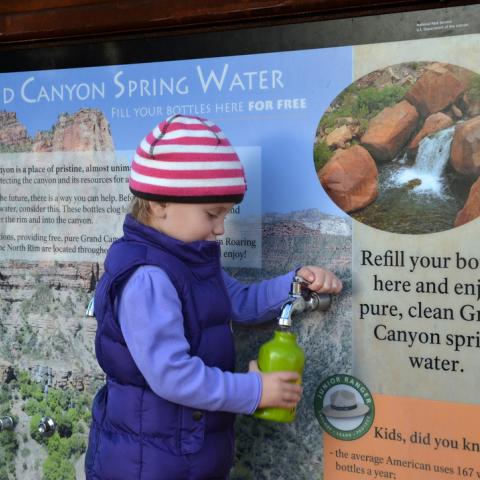
Hotels on the South Rim of Grand Canyon National Park can reopen Thursday/NPS file
Hotels on the South Rim of Grand Canyon National Park have been told they can reopen Thursday following repairs to the aged waterline that carries water to the rim.
While it had been assumed the repairs and testing would take up most of this week and prevent the hotels from reopening until the weekend, on Tuesday afternoon a park release said utility crews had "successfully completed complex repairs to the Transcanyon Waterline late last week and resumed pumping water without identifying any new breaks."
The National Park Service had temporarily suspended overnight hotel accommodations on August 29. Since July 8, the 12½ mile-long Transcanyon Waterline, which supplies water from the canyon for use in the park, has had four significant breaks. Until "highly complex repairs" were completed last week, no water was being pumped to either the South or North Rim and the park’s water storage was quickly falling to unsustainable levels, the release said.
While the hotels will be allowed to reopen, the park will continue to operate under water conservation measures to ensure "sustainable management of water resources."
Read about the infrastructure needs at Grand Canyon National Park
Key updates for the South Rim:
Overnight accommodations: Beginning Thursday, overnight accommodations will resume at park lodges. This includes facilities operated by Xanterra, such as El Tovar, Bright Angel Lodge, Maswik Lodge, and Phantom Ranch, as well as Delaware North’s Yavapai Lodge and Trailer Village. Reservations are now open, and visitors can book stays at these locations.
Camping: Dry camping will still be permitted, and water spigots at Mather Campground and Desert View Campground will remain turned off. However, visitors can access water at the Mather Campground check-in kiosk.
Fire Restrictions: Fire restrictions will continue for the South Rim, prohibiting all wood burning, charcoal fires, and campfires in South Rim and inner canyon areas to support water conservation efforts.
Ongoing Conservation Measures: Visitors and residents are encouraged to continue practicing water conservation:
- Limit showers to five minutes or less
- Turn off faucets while shaving or brushing teeth
- Flush toilets selectively
- Wash laundry with full loads
- Report leaks to park authorities
Following waterline repairs, potable water along the North Kaibab Trail, including at Phantom Ranch, is now available. Hikers should still prepare to bring or treat water if necessary. For current water status in the inner canyon, visit the park’s Critical Backcountry Updates page.
Originally built in the 1960s, the Transcanyon Waterline provides potable water for facilities on the South Rim and inner canyon. The waterline has exceeded its expected lifespan and experiences frequent failures, which require expensive and continuous maintenance work to repair leaks. Since 2010, there have been over 85 major breaks that have each disrupted water delivery. The National Park Service recently started construction on a multi-year, $208 million rehabilitation of the Transcanyon Waterline and upgrades to the associated water delivery system. This crucial investment in infrastructure will ensure the park is able to meet water supply needs for six million annual visitors and approximately 2,500 year-round residents.
The project is expected to be completed in 2027. The Great American Outdoors Act (GAOA) is providing more than $100 million to replace the South Rim Wastewater Treatment Plant which services visitor, staff, lodging and support facilities. GAOA is part of a concerted effort by the National Park Service to address extensive deferred maintenance and repair needs in national parks.




 Support Essential Coverage of Essential Places
Support Essential Coverage of Essential Places







Comments
Like the concessionaire at Crater Lake that got booted, how are GC concessionaries supposed to make money when the NPS cannot reasonably ensure that he infrastructure will be in place and wokring in order for the concessionaires to operate?
The only thing worse than to shut down GC lodges, is to continue to operate GCNP under a cloud of perpetual uncertainty of another shutdown?
I'm no apologist for concessionaires at GC, but gawd awful, how are they to make money when the NPS is bound to shut them down again because the NPS cannot maintain the water system? How many folks will simply not visit or make reservatiions because of the uncertainty?